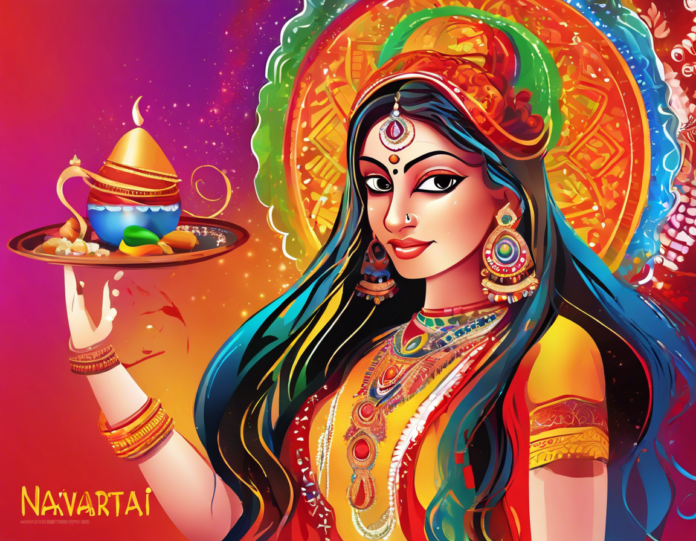Navratri, a vibrant and joyous festival celebrated in India, spans nine days and nights of fervent devotion and high-spirited festivities. Each day of Navratri is dedicated to a different form of Goddess Durga, symbolizing power, strength, and wisdom. One notable aspect of Navratri is the tradition of wearing specific colors on each day that represent various aspects of life and spirituality. These colors are believed to invoke specific energies and blessings associated with the different forms of Goddess Durga. In this article, we will delve into the significance of Navratri colors, providing a day-wise guide for Navratri Colors 2023.
Day 1: Grey
The first day of Navratri is dedicated to Shailaputri, the embodiment of the mountains. Grey, the color associated with this day, signifies the strength and stability of the mountains. It represents the calmness and tranquility required to embark on the spiritual journey of Navratri.
Day 2: Orange
The second day celebrates Goddess Brahmacharini, symbolizing love and loyalty. Orange is the color of the day, signifying enthusiasm, creativity, and success. It represents the vibrant energy that propels us towards our goals.
Day 3: White
Goddess Chandraghanta, who represents peace and serenity, is worshipped on the third day. White is the color associated with this day, symbolizing purity, clarity, and new beginnings. It signifies the purification of thoughts and actions.
Day 4: Red
On the fourth day, devotees honor Goddess Kushmanda, the creator of the universe. Red is the color of the day, representing power, passion, and vitality. It symbolizes the strength and energy required to overcome challenges.
Day 5: Royal Blue
Goddess Skandamata, the protector of her devotees, is revered on the fifth day. Royal Blue is the color associated with this day, symbolizing intelligence, knowledge, and wisdom. It represents the guidance and protection of Goddess Skandamata.
Day 6: Yellow
The sixth day celebrates Goddess Katyayani, the warrior goddess who embodies courage and strength. Yellow is the color of the day, signifying happiness, optimism, and prosperity. It represents the inner strength and determination to face adversities.
Day 7: Green
Goddess Kalaratri, the destroyer of ignorance and evil, is worshipped on the seventh day. Green is the color associated with this day, symbolizing growth, harmony, and fertility. It represents the rejuvenation and transformation of the self.
Day 8: Peacock Green
On the eighth day, devotees honor Goddess Mahagauri, who symbolizes peace and forgiveness. Peacock Green is the color of the day, signifying balance, healing, and compassion. It represents the inner purity and grace of Goddess Mahagauri.
Day 9: Purple
The ninth day celebrates Goddess Siddhidatri, the grantor of wishes and spiritual enlightenment. Purple is the color associated with this day, symbolizing luxury, sophistication, and spiritual growth. It represents the culmination of the spiritual journey and the attainment of divine blessings.
By following the tradition of wearing Navratri colors each day, devotees not only pay homage to the various forms of Goddess Durga but also invite their respective qualities and blessings into their lives. The vibrant spectrum of colors reflects the diversity of attributes embodied by the Goddess and serves as a reminder of the power and grace present within each individual.
Navratri Colors: Significance and Symbolism
- Grey: Strength and Stability
- Orange: Enthusiasm and Creativity
- White: Purity and Clarity
- Red: Power and Vitality
- Royal Blue: Knowledge and Wisdom
- Yellow: Happiness and Prosperity
- Green: Growth and Harmony
- Peacock Green: Balance and Compassion
- Purple: Spiritual Growth and Enlightenment
In conclusion, the Navratri colors play a significant role in the celebration of this auspicious festival, infusing each day with symbolism, energy, and devotion. By embracing these colors and their meanings, devotees can deepen their connection to Goddess Durga and embark on a transformative spiritual journey during Navratri.
Frequently Asked Questions (FAQs)
-
Why are specific colors worn during Navratri?
Specific colors are worn during Navratri to represent the different forms of Goddess Durga and invoke their respective energies and blessings. -
Can I wear different shades of the recommended colors for Navratri?
Yes, you can wear different shades of the recommended colors as long as they align with the symbolism of the day. -
What happens if I don’t wear the designated color for a particular day of Navratri?
While wearing the designated color is traditional, the most important aspect of Navratri is sincere devotion and reverence towards Goddess Durga. -
Are there any specific rituals associated with wearing Navratri colors?
There are no specific rituals associated with wearing Navratri colors, but it is recommended to dress in clean and comfortable attire during the festival. -
Can men also participate in wearing Navratri colors?
Yes, men can also participate in wearing Navratri colors as a sign of respect and devotion towards Goddess Durga. -
What if I am unable to find an outfit in the designated color for a particular day of Navratri?
If you are unable to find an outfit in the designated color, you can opt for accessories or elements in that color to align with the tradition. -
Do people outside India also follow the tradition of wearing Navratri colors?
Yes, the tradition of wearing Navratri colors has gained popularity beyond India, with people around the world participating in the festive celebrations. -
Are there any specific guidelines for choosing accessories to match the Navratri colors?
While there are no strict guidelines, you can choose accessories such as jewelry, scarves, or footwear in the designated colors to complement your outfit during Navratri. -
Can I wear makeup in the Navratri colors to align with the tradition?
Yes, you can incorporate makeup in the Navratri colors to enhance your festive look and align with the traditional symbolism of each day. -
How can I incorporate Navratri colors into my home decor during the festival?
You can decorate your home with flowers, drapes, and ornaments in the Navratri colors to create a festive and auspicious ambiance during the nine days of the festival.
Embracing the tradition of Navratri colors not only adds a splash of vibrancy to the festivities but also connects devotees to the spiritual essence and significance of each day of the festival. By infusing your attire and surroundings with the designated colors, you can enhance your Navratri experience and draw closer to the divine blessings of Goddess Durga.


Recent comments